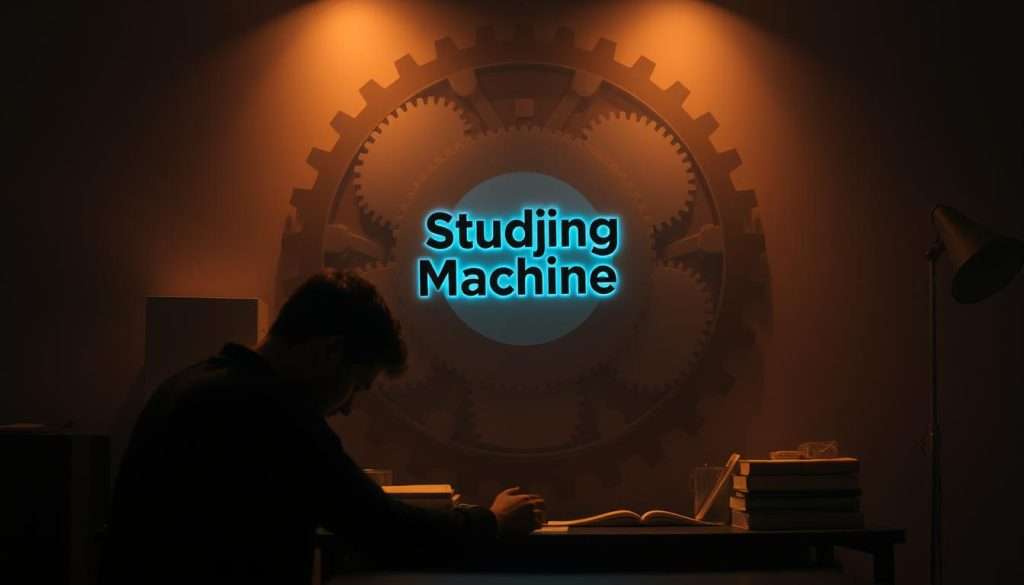We’ve all been there – trying to take in a lot of information at once. It feels overwhelming and confusing. This is where Cognitive Load Theory (CLT) comes in. It was developed by John Sweller to explain how our brains handle and keep information.
CLT says our working memory can only hold so much. When it’s too full, learning gets tough. By grasping how CLT works, you can optimize your learning process. This makes studying more effective and even fun!
So, how can you use CLT to change your learning experience? By controlling your mental load, you can concentrate better, keep information longer, and reach your learning goals faster.
Key Takeaways
- Understand how Cognitive Load Theory can improve your learning.
- Learn to manage your working memory capacity.
- Discover strategies to optimize your study process.
- Transform studying into an enjoyable experience.
- Achieve your learning goals more efficiently with CLT.
What is Cognitive Load Theory?
Learning can change when you grasp Cognitive Load Theory. It shows the best ways to learn and remember. This idea comes from educational psychology and helps us understand how we learn.
The Science Behind Information Processing
Our brains handle new info through working memory and long-term memory. John Sweller, a key figure in Cognitive Load Theory, says knowing this is key to learning well.
How Your Brain Handles New Information
New info first goes into our working memory, which can only hold so much. Managing this is crucial for learning.
Working Memory Limitations
Working memory limits are at the heart of Cognitive Load Theory. Studies show our working memory can hold about seven chunks of info, give or take two. This is Miller’s Law.
The Magic Number Seven (Plus or Minus Two)
This means we should be careful about how much info we try to process at once. Breaking down complex info into smaller bits helps a lot with learning.
Long-term Memory and Schema Formation
Info that makes it past working memory goes to long-term memory. There, it becomes schemas or frameworks that help us understand new info. Building on what we already know is a great way to learn new things.
Understanding Cognitive Load Theory helps us see why managing our brain’s load is important for learning. It’s about knowing our working memory limits and using strategies to improve how we process and remember info.
The Three Types of Cognitive Load
The Cognitive Load Theory divides cognitive load into three main types: intrinsic, extraneous, and germane. Knowing these types is key to managing cognitive load well and improving learning.
Intrinsic Cognitive Load: Task Complexity
Intrinsic cognitive load is the natural difficulty of a task or the complexity of what we’re learning. It’s the effort needed to grasp and process the information.
Why Some Topics Are Inherently Difficult
Some subjects are harder because they’re complex or involve abstract concepts. For example, advanced math or complex scientific theories are naturally challenging.
Extraneous Cognitive Load: Distractions and Poor Design
Extraneous cognitive load comes from outside the task, like distractions or bad design. This load is not needed and can be reduced with better design.
Unnecessary Mental Effort
When learning materials are unclear or the environment is distracting, it adds extra mental work. A messy webpage or a noisy study area can increase this load.
Germane Cognitive Load: Meaningful Learning
Germane cognitive load is the effort put into really understanding the material. It’s about making connections and building schemas.
The “Good” Cognitive Load
Germane cognitive load is the “good” kind because it leads to meaningful learning and expertise. It means actively engaging with and making sense of the material.
By grasping and managing these three cognitive load types, learners and designers can create better learning experiences.
Assessing Your Current Cognitive Load
Understanding your cognitive load is key to better learning. When the load is too high, it can make learning harder. This happens when you try to remember too much at once.
Recognizing Cognitive Overload Symptoms
To handle your cognitive load, first spot the signs. Feeling tired, forgetting things, or struggling to focus are clues. If you see these signs, your load is too much.
Self-assessment Techniques
Self-checking is a great way to manage your load. Use Mental Effort Rating Scales to measure how hard you’re working. These scales help you see how much effort you’re putting into tasks.
Mental Effort Rating Scales
Mental Effort Rating Scales are easy to use. They ask you to rate how hard a task is, from 1 to 9. For instance, reading a tough chapter might get an 8, while a video might get a 4.
| Task | Mental Effort Rating |
|---|---|
| Reading a complex chapter | 8 |
| Watching a video tutorial | 4 |
Identifying Personal Learning Bottlenecks
By checking your load often and using Mental Effort Rating Scales, you can find what’s holding you back. These are tasks that always make you feel overwhelmed, slowing down your learning.
“The key to improving your learning is not to avoid challenges, but to understand your limits and work within them.”
Knowing and managing your cognitive load helps you learn better. It makes your studying more efficient and effective.
Strategies to Manage Intrinsic Cognitive Load
Managing intrinsic cognitive load is key to learning well. We’ll look at some ways to do this. Intrinsic cognitive load is the effort needed to understand complex info. By breaking down tasks, building knowledge, and using progressive learning, learning becomes easier and more fun.
Breaking Complex Tasks into Manageable Chunks
Breaking down big tasks into smaller ones is a good strategy. This is called the chunking method. It helps by focusing on one part at a time, reducing mental overload.
The Chunking Method in Practice
For example, learning a new programming language can be tough. Instead of trying to learn everything at once, start with the basics. Learn about variables and data types first, then move on to loops and functions. This makes learning feel less overwhelming.
Pre-training and Building Prior Knowledge
Building prior knowledge through pre-training is also helpful. This means introducing learners to key concepts before diving into harder material. It helps reduce the mental effort needed for more complex tasks.
For instance, when learning a complex scientific theory, start with the basics. Knowing the foundation makes understanding the details easier later on.
Progressive Learning Approaches
Progressive learning means gradually increasing the difficulty of material as learners get better. This way, learners are not hit with too much information at once.
From Simple to Complex
Learning to play a musical instrument is a good example. Start with simple melodies and move to harder pieces as you get better. This approach keeps the cognitive load manageable by always challenging but not overwhelming.
| Strategy | Description | Benefit |
|---|---|---|
| Chunking Method | Breaking down complex tasks into smaller chunks | Reduces mental overload |
| Pre-training | Building prior knowledge before complex tasks | Establishes a knowledge foundation |
| Progressive Learning | Gradually increasing complexity as proficiency improves | Manages cognitive load effectively |
Using these strategies can help manage intrinsic cognitive load. This makes learning more efficient and enjoyable.
Reducing Extraneous Cognitive Load
To learn better, we must fight extraneous cognitive load. This means making our learning space better. It’s about cutting down on distractions and bad design, not the learning itself.
Optimizing Your Learning Environment
Your study area is key to your focus. Make a dedicated study space that’s quiet, comfy, and free from distractions. It’s vital.
Creating Distraction-Free Zones
Choose a spot for studying with no interruptions. This could be a home office or a quiet library corner. Turn off digital alerts or use apps to stay on track.
Eliminating Multitasking
Multitasking adds to the mental load. Focus on one thing at a time. Try the Pomodoro Technique for 25 minutes of work, then a 5-minute break.
Streamlining Information Presentation
How we see information matters. Use clear, simple materials that are well-organized and easy to understand.
Note-taking Techniques That Reduce Cognitive Load
Good note-taking is key for learning. Try the Cornell Note-taking System or mind mapping. They help organize info for easy review. Find what works for you.
Using these tips can cut down on mental load and boost learning. The aim is to make learning easy and fun.
Enhancing Germane Cognitive Load for Better Learning
To really understand new stuff, we need to think hard about it. This is what germane cognitive load is all about. It’s the effort we put into learning that really matters. By focusing on this, we learn better and enjoy it more.

Elaboration Techniques
Boosting germane cognitive load is easy with elaboration techniques. These help us connect new info to what we already know. This makes learning richer and more meaningful.
Connecting New Information to Existing Knowledge
Learning something new is better when we link it to what we already know. For instance, learning a new language is easier when we connect new words to familiar ones. This connection-making helps us understand and remember better.
Self-explanation Strategies
Self-explanation strategies are also key. They mean explaining what we learn in our own words. This helps us get it clearer and spot any missing pieces.
Meaningful Practice Methods
Meaningful practice methods are vital too. They’re not just about memorizing stuff. They’re about using what we learn in real ways.
Spaced Repetition and Retrieval Practice
Spaced repetition and retrieval practice are two great examples. Spaced repetition helps us remember things for longer by reviewing them at the right times. Retrieval practice, on the other hand, makes us recall info from memory instead of just reading it again. Both methods really help us learn better.
By using these strategies, we can make our learning more effective and fun. It’s all about putting in the effort to really understand and enjoy what we learn.
Applying Cognitive Load Theory in Digital Learning
The world of digital learning is changing fast. Cognitive Load Theory is key to making learning better. It’s important to know how to use it well with digital tools in schools.
Multimedia Learning Principles
Multimedia learning uses pictures and sounds to teach. It helps learners understand and remember better by using different ways to show information.
The Dual-Channel Processing Advantage is a big idea here. Using pictures and sounds together helps learners handle information better. This makes learning less stressful.
The Dual-Channel Processing Advantage
This idea says mixing images, text, and audio makes learning better. For example, watching a video with both sound and subtitles is more helpful than just reading.
E-learning Design Considerations
When making e-learning, we need to make it easy to understand. This means:
- Making it easy to navigate and look at
- Keeping it simple and avoiding too many animations or distractions
- Using clear and easy-to-understand language
By making the learning space simpler, learners can focus better on what they’re learning.
Tools and Apps That Support Cognitive Load Management
There are many digital tools to help manage cognitive load. These include:
- Flashcard apps like Anki for spaced repetition
- Note-taking apps like Evernote to organize information
- Tools like Freedom to help stay focused and avoid distractions
Digital Tools for Different Learning Styles
Each learner is different and needs different tools. For example, visual learners might like MindMeister for mind maps. Auditory learners might prefer Apple Podcasts for listening.
Practical Applications Across Different Subjects
Cognitive Load Theory (CLT) is more than just a theory. It’s a tool that helps in learning many subjects. By managing cognitive load, students can study better and achieve more in various fields.
Mathematics and Science Learning
Math and science are full of complex problems and abstract ideas. CLT is perfect for these subjects.
Worked Examples and Problem-Solving
Using worked examples is a great strategy. It shows how to solve problems step by step. This makes it easier for students to understand the main ideas.
Language Acquisition
Learning a new language can be tough. But CLT helps manage the mental effort needed to learn new words and grammar.
Vocabulary Building Without Overload
Introducing new words slowly is key. Focus on learning them in context and repeat them often. This builds a solid base without overwhelming students.

Skill Development and Procedural Learning
CLT also helps in learning new skills and procedures. It’s about getting practical skills, not just book knowledge.
From Novice to Expert: Managing Cognitive Load
As students get better, they need to change how they handle mental load. Beginners should break down hard tasks into easy parts. More experienced learners can then put their knowledge together in complex ways.
| Subject Area | CLT Application | Benefits |
|---|---|---|
| Mathematics and Science | Worked examples, problem-solving strategies | Reduced extraneous load, improved understanding |
| Language Acquisition | Gradual vocabulary introduction, contextual learning | Effective vocabulary building, reduced cognitive overload |
| Skill Development | Task breakdown, practice, and feedback | Improved skill acquisition, enhanced performance |
Conclusion: Implementing Cognitive Load Theory in Your Learning Journey
Understanding Cognitive Load Theory (CLT) can really help you learn better. It shows how to handle different kinds of mental load. This way, you can learn more and remember it longer.
We talked about how to figure out your mental load. We also showed how to break down hard tasks and make your study space better. These steps help you focus on what’s important and learn more effectively.
Using CLT in your study routine can change everything. Look for places where you feel too much stress. Then, use the tips from this article to make things better. You’ll learn faster and feel more sure of yourself.
Your path to learning is special, and CLT can make it even better. We hope you’ll try this out and see how it changes your learning.

